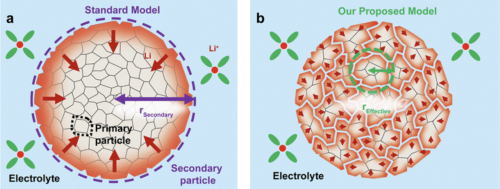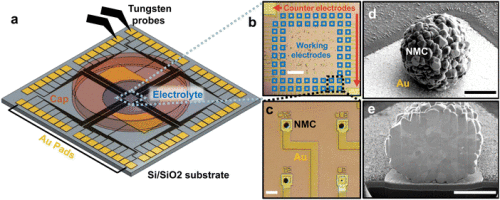Energy & Critical Metals
U Michigan study finds cracking in Li-ion batteries speeds up EV charging
Rather than being solely detrimental, cracks in the cathodes of lithium-ion batteries reduce battery charge time, according to research done at the University…

Rather than being solely detrimental, cracks in the cathodes of lithium-ion batteries reduce battery charge time, according to research done at the University of Michigan. This runs counter to the view of many electric vehicle manufacturers, which try to minimize cracking because it decreases battery longevity. An open-access paper on the work is published in the RSC journal Energy & Environmental Science.
Polycrystalline Li(Ni,Mn,Co)O2 (NMC) secondary particles are the most common cathode materials for Li-ion batteries. During electrochemical (dis)charge, lithium is believed to diffuse through the bulk and enter (leave) the secondary particle at the surface. Based on this model, smaller particles would cycle faster due to shorter diffusion lengths and larger surface-area-to-volume ratios. In this work, we evaluate this widespread assumption by developing a new high-throughput single-particle electrochemistry platform using the multi-electrode array from neuroscience. By measuring the reaction and diffusion times for 21 individual particles in liquid electrolytes, we find no correlation between the particle size and either the reaction or diffusion times, which is in stark contrast to the prevailing lithium transport model.
We propose that electrochemical reactions occur inside secondary particles, likely due to electrolyte penetration into cracks. Our high-throughput, single-particle electrochemical platform further opens new frontiers for robust, statistical quantification of individual particles in electrochemical systems.
—Min et al.
Proposed mechanism for size-independent reaction and diffusion times (a) The standard model for particle-level lithium transport assumes that lithium enters the surface of the secondary particles and diffuses into the bulk. As a result, the effective diffusion length increases with the secondary particle diameter. (b) Min et al. propose the relevant length scale (rEffective) is much shorter than the radius of the secondary particle, and is independent of the secondary particle diameter. One possibility is that the electrolyte penetrates the particle due to intergranular cracking. Min et al.
The team believes the findings apply to more than half of all electric vehicle batteries, in which the cathode is composed of trillions of microscopic particles made of either lithium nickel manganese cobalt oxide or lithium nickel cobalt aluminum oxide.
Theoretically, the speed at which the cathode charges comes down to the particles’ surface-to-volume ratio. Smaller particles should charge faster than larger particles because they have a higher surface area relative to volume, so the lithium ions have shorter distances to diffuse through them.
However, conventional methods couldn’t directly measure the charging properties of individual cathode particles, only the average for all the particles that make up the battery’s cathode. That limitation means the widely accepted relationship between charging speed and cathode particle size was merely an assumption.
Measuring the charging speed of individual cathode particles was key to discovering the upside to cracking cathodes. The researchers accomplished this by inserting the particles into a multi-electrode array—a device that is typically used by neuroscientists to study how individual brain cells transmit electrical signals.
Design and fabrication of multi-electrode arrays (a) Schematic illustration of high-throughput multi-electrode array. Au microelectrodes are patterned on a silicon substrate with 500 nm thermal oxide. Au contact pads, about 1 mm each, are patterned on the boundary of the array and electrically connected to the microelectrodes in the center. (b) An optical image of the electrodes. The chip contains 2 large counter/reference electrodes and 62 smaller working microelectrodes. (c) Magnified image of four working microelectrodes with assembled NMC particles. Each Au microelectrode is 20 × 20 µm; the Au wires are passivated with 50 nm of silicon nitride. (d) SEM image of a particle on a working microelectrode. (e) Cross-section SEM of a particle obtained using plasma focused ion beam milling. The scale bars in each image equal 300 µm (b), 30 µm (c), 3 µm (d), 3 µm (e) respectively. Min et al.
The benefits of cracked materials are important to consider when designing long-lived batteries with single-crystal particles that don’t crack. To charge quickly, these particles may need to be smaller than today’s cracking cathode particles. The alternative is to make single-crystal cathodes with different materials that can move lithium faster, but those materials could be limited by the supply of necessary metals or have lower energy densities, Yiyang Li, assistant professor of materials science and engineering and corresponding author of the study said.
The device was built in the Lurie Nanofabrication Facility and studied at the Michigan Center for Materials Characterization.
The research was funded by LG Energy Solution, Battery Innovation Contest and the University of Michigan College of Engineering.
Resources
-
Jinhong Min, Lindsay M. Gubow, Riley J. Hargrave, Jason B. Siegel and Yiyang Li (2023) “Direct measurements of size-independent lithium diffusion and reaction times in individual polycrystalline battery particles” Energy Environ. Sci. doi: 10.1039/D3EE00953J
lithium
cobalt
manganese
batteries
electric vehicle
li-ion
aluminum

Uranium Exploration Company Announces Additional Staking in the Athabasca Basin
Source: Streetwise Reports 12/22/2023
Skyharbour Resources Ltd. announced an update from its Canada-based Falcon Project along with additional…
Tesla Launches New Mega Factory Project In Shanghai, Designed To Manufacture 10,000 Megapacks Per Year
Tesla Launches New Mega Factory Project In Shanghai, Designed To Manufacture 10,000 Megapacks Per Year
Tesla has launched a new mega factory…
Giving thanks and taking stock after “a remarkable year”
An end-of-year thank you to our readers, industry colleagues and advertisers before Electric Autonomy breaks from publishing until Jan. 2
The post Giving…












